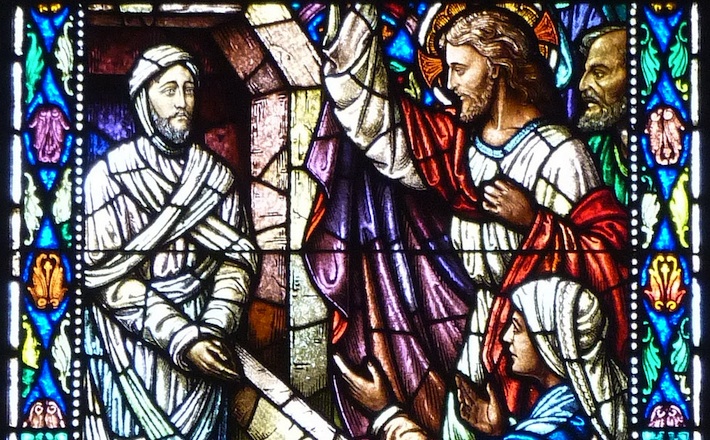Commentary on John 11:32-44
Today’s text gathers us around a newly occupied tomb, surrounded by the typical mix of grief and loss, accusation and anger.
In that unlikely setting, Jesus tells Martha that she will see the glory of God (John 11:40). We know what it is to long for a glimpse of that glory, perhaps especially at times reflected in the scenes of John 11. On this All Saints Sunday, we remember the long line of the faithful who have come before us, whom we honor and treasure. Yet we may also wonder just where we see God’s glory in a procession that always ends up at a death. We know from experience how death, with all its daily minions, stinks. Where is it that we glimpse God’s glory?
“The dead man came out” (John 11:44). It would be difficult to imagine a more unlikely sentence. This is utterly beyond our experiences. We’ve been given plenty of indication earlier in John 11 about what will happen, but we may still be startled by the man shuffling out of the tomb, unexpectedly alive. Surely such a miracle is where the glory of God blazes forth.
Except this expectation doesn’t seem to play out in the text. In John11:36-37, the people at the funeral are divided about Jesus. Some affirm his love; others criticize him for not doing more for sadly dead Lazarus. The reaction is no less divided (but it is more deadly) after Lazarus stumbles his way back into the light of the living. Jesus ensures freedom for Lazarus in verse 44, but the following verses note that although some believe because of what they saw (verse 45), others begin to plan how to kill both Jesus (verse 53) and Lazarus (John 12:10), and thus stop the outrageous behavior of one who calls the dead back to life, and of the dead who have the temerity to obey.
Perhaps such reactions prompt what may be the most exegetically puzzling aspect of this text: the profound emotional responses of Jesus. He is “greatly disturbed” in John 11:33 and 38, a word that commonly signifies indignation or anger. He is “deeply moved” (verse 33); he weeps (verse 35). What is all this about? Is it an indication of human grief felt by Jesus? Is he upset because the crowd’s grief is hypocritical? Is he angry at people’s continued inability to believe (this weeping as a Johannine version of the Synoptic Jesus weeping over Jerusalem)? Is he upset because his own death and tomb are approaching?
Commentators are intrigued by this emotional Jesus, and all of these suggestions have some plausibility within John’s narrative. Unfortunately, John doesn’t seem interested in clarifying the reasons for Jesus’ emotions here. Whatever the precise trigger, it is worth noticing that Jesus does not remain unmoved in the presence of this death and grief. Such things are not overcome by Spock-like lack of emotion; that is not how God’s glory will appear.
Though not specifically labelled as such, the raising of Lazarus is the climactic “sign” within Jesus’ ministry in John. In this Gospel, the astounding things Jesus does are not “miracles,” not simply places where the general patterns of the world swerve wildly. Instead, they are revelations, signs that point beyond the astounding event itself to something else. More precisely, they point to someone else. They testify to Jesus as the Son to whom the Father has given life (John 5:25-26). This scene points to Jesus’ own glorification through his death and resurrection (12:23). There too we will find a tomb, a stone, grieving women, the linen wrappings and face cloth. This means that if we focus on Lazarus being brought back to life and perhaps even wrestle with why others whom we love were not similarly brought back, we have missed the point rather badly. This text is also not simply about how Jesus will raise us on the last day. This was Martha’s confession, and (though true) it was not sufficient. Jesus calls Lazarus out, like the good shepherd who calls his sheep and gives them life (10:3, 27-28). This is what Jesus does for all those who believe in him. Jesus has the power to give life now, because Jesus is the presence of God’s life become flesh for us.
Jesus raising Lazarus does not negate the promise of the day that is coming when all those in the tombs will hear his voice and come out (John 5:28), but it is not primarily about that claim. What it reveals is that Jesus is the one in whom there is life (1:4), the one who even now calls us out of all the dark and binding places of death (5:25). In grief, people do not only need or want to know that Jesus is powerful enough to raise the dead. After all, then why didn’t Jesus do more to help their own family member, or to stop the monstrous daily march of death through our world? But Jesus is life itself; Jesus himself is resurrection’s defeat of death. Jesus is the place where death ends and everlasting life begins. Without denying the eschatological promise of resurrection and death’s final elimination, the life of Jesus breaks into our present and transforms it. What we need to hear is that on both sides of the grave there is life for us because Jesus has been sent to call our names. On both sides of the grave Jesus is life for us.
This is what All Saints Day is for: not just to remember those from long ago or those whose deaths are still painfully near, and not just to point ahead to that ultimate promise of resurrection, though both of these are certainly part of this day and to be affirmed. More centrally, however, this day is about what all God’s saints have known and experienced, that here and now there is no death or grief or fear so deep and dark that the voice of Jesus cannot reach into it, call us out, and bring life.


November 4, 2018